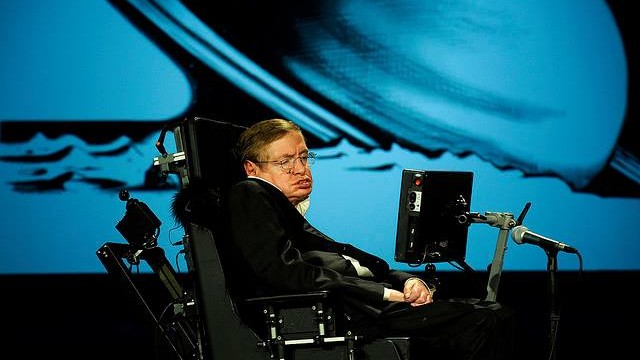Photo courtesy of NASA/Paul E. Alers
By Ahmad A. Malik
Stephen Hawking, celebrated theoretical physicist and cosmologist, has predicted that the destruction of the known universe by the Higgs Field is imminent, and may have already occurred. The Cambridge professor warned in recent comments that at high energy levels, the particle housed in this particular field, the Higgs Boson, will become unstable and lead to the collapse of both time and space.
“The Higgs potential has the worrisome feature that it might become metastable at energies above 100 billion gig-electron-volts,” Hawking wrote. “This could mean that the universe could undergo catastrophic vacuum decay, with a bubble of the true vacuum expanding at the speed of light. This could happen at any time and we wouldn’t see it coming.”
Hawking explained that this event may have already occurred and could be making its way to Earth, and that because it would travel at the speed of light, it is undetectable and otherwise unknown to humans.
The remarks came in a foreword which Hawking has written for an anthology of essays by cosmologists entitled Starmus: 50 Years of Man in Space, expected to be completely released later this month. Some in the scientific community have called them a publicity stunt.
The discovery of the Higgs Boson has taken the physics profession by storm in the last two years, confirming what scientists have been theorizing for decades.
“It gives mass to other particles by saying that the universe is full of Higgs Bosons,” said Robert McCarthy, the physics undergraduate director at Stony Brook University. “It is a spin zero particle with no charge, and completes the Standard Model.”
The application of what is known as the Standard Model essentially accepts the existence of the particle, because without something like it, the model would cease to make mathematical sense. The Higgs Boson, which can be considered either a particle or an equivalent field, was predicted in the Standard Model. To the credit of physicists, the Higgs Boson was discovered at the mass at which it was calculated to be.
“A more useful analogy is to think about what happens when a celebrity walks through a crowd,” said John Hobbs, a theoretical physicist at Stony Brook University, who has been directly involved in Higgs searches via the DZero collaboration at Fermilab
Hobbs currently works with the ATLAS Collaboration at CERN, the European Organization for Nuclear Research, where the Higgs Boson was co-discovered.
“Because she’s a celebrity, people want her to stop and talk, so her progress is slowed,” Hobbs said. “Someone else who’s not a celebrity would get through the crowd faster.”
In the analogy Hobbs offered, the Higgs field is the crowd and the celebrity is a particle. A slower particle is one with more mass, and the Higgs field gives mass to all particles. The non-celebrity is a less popular and therefore less massive particle that is less affected by the Higgs field.
Hawking’s comments state that the universe remains stable because of the given mass of the Higgs Boson. If the mass was to change, the universe would disintegrate – but only after a very long period of time with particular forces at play.
“The issue has to do with a concept called metastability,” Hobbs said.
Hobbs explains the concept to be like a ball on a hill with a small bump halfway down one side. If the ball is sitting in the valley between the hill and the bump, he explained, it won’t move. But if somehow it gets a little bit of motion, Hobbs said, it can go over the bump and roll all the way down the hill. The position in the valley is called metastable because the ball may suddenly move a long way with out being moved very much, Hobbs added.
Hawking’s remarks, though mathematically sound, have been received with displeasure in the physics community. While the “end of the universe,” makes for a great headline, those scientifically literate understand that the Higgs field does not pose a burgeoning threat to the universe. For one, the Standard Model is a rather basic calculation that does not allow for the existence of dark matter, which is widely accepted as existing in the universe. In other words, the name beholds its application in reality – it is simply a model, not accounting for innumerable variables.
“This whole calculation is based on assumptions, which is very important,” said Yiming Zhong, a graduate student at Stony Brook University’s C.N. Yang Institute for Theoretical Physics. “Even if you believe that the assumption is correct - that there is no [dark] particle, which is not the case – then tunneling from one vacuum to another vacuum is not possible by any human being.”
With no imminent danger looming over the public, the question remains whether Hawking’s remarks were made as a function of scientific inquiry or as publicity for Starmus.
“What he’s saying in physics terms is right, but it may not be a very responsible thing to say to the public,” said Harikrishnan Ramani, a graduate student at Stony Brook University’s theoretical physics program.
So while the universe may be teetering on the scale of equilibrium and destruction, it seems unlikely that the latter has dawned on the Earth, as Hawking claims it may have.
“The dividing lines have been calculated,” said Hobbs, “and it turns out that for mass that the actual Higgs Boson has, our universe is near the metastable situation.”
This has nothing to do with the fact that the Higgs Boson was just discovered, Hobbs said. If it’s true, it’s always been true and always will be true, he added.
“The discovery has simply allowed us to know where we stand,” Hobbs said.


